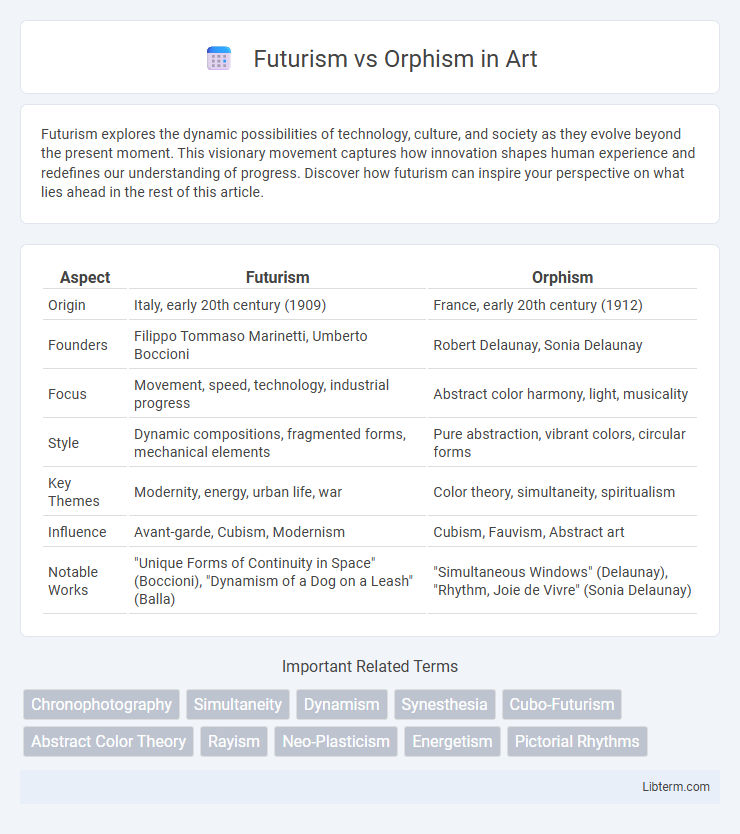Futurism explores the dynamic possibilities of technology, culture, and society as they evolve beyond the present moment. This visionary movement captures how innovation shapes human experience and redefines our understanding of progress. Discover how futurism can inspire your perspective on what lies ahead in the rest of this article.
Table of Comparison
| Aspect | Futurism | Orphism |
|---|---|---|
| Origin | Italy, early 20th century (1909) | France, early 20th century (1912) |
| Founders | Filippo Tommaso Marinetti, Umberto Boccioni | Robert Delaunay, Sonia Delaunay |
| Focus | Movement, speed, technology, industrial progress | Abstract color harmony, light, musicality |
| Style | Dynamic compositions, fragmented forms, mechanical elements | Pure abstraction, vibrant colors, circular forms |
| Key Themes | Modernity, energy, urban life, war | Color theory, simultaneity, spiritualism |
| Influence | Avant-garde, Cubism, Modernism | Cubism, Fauvism, Abstract art |
| Notable Works | "Unique Forms of Continuity in Space" (Boccioni), "Dynamism of a Dog on a Leash" (Balla) | "Simultaneous Windows" (Delaunay), "Rhythm, Joie de Vivre" (Sonia Delaunay) |
Introduction to Futurism and Orphism
Futurism, emerging in early 20th-century Italy, emphasized dynamic movement, speed, and technological progress as core themes. Orphism, a parallel art movement, focused on abstract, vibrant color and lyrical forms inspired by musical rhythm and harmony. Both movements contributed to the evolution of modern art but diverged in their conceptual approaches: Futurism celebrated industrial energy, while Orphism explored pure abstraction and color theory.
Historical Contexts of Futurism and Orphism
Futurism emerged in early 20th-century Italy amid rapid industrialization and technological advancements, celebrating speed, innovation, and the dynamic energy of modern life. Orphism developed in Paris around 1912, influenced by Cubism but distinguished by its emphasis on vibrant colors and lyrical abstraction, reflecting the city's avant-garde artistic circles. Both movements responded to the era's cultural shifts, with Futurism promoting radical change and Orphism exploring spiritual and sensory experiences through color and form.
Key Philosophies and Motivations
Futurism emphasized speed, technology, and dynamic movement as symbols of modernity, celebrating industrial progress and rejecting traditional artistic conventions. Orphism focused on abstract color harmonies and spiritual expression, drawing inspiration from Cubism while seeking to evoke emotional and poetic responses through vibrant palettes. Both movements explored fragmentation and innovation, but Futurism was driven by a fascination with urban energy and machinery, whereas Orphism prioritized lyrical abstraction and metaphysical themes.
Defining Visual Elements of Futurism
Futurism emphasizes dynamic movement, speed, and technological advancement through fragmented forms and multiple perspectives that create a sense of energy and motion. Its defining visual elements include bold lines, vibrant colors, and repetitive shapes that depict industrial progress and urban life. This contrasts with Orphism's focus on lyrical abstraction and vibrant color harmonies, highlighting Futurism's unique emphasis on mechanization and kinetic force.
Distinctive Features of Orphism
Orphism is characterized by its vivid use of color and abstract forms, emphasizing lyrical and musical qualities that contrast with Futurism's focus on dynamic movement and industrial themes. Unlike Futurism's celebration of speed, technology, and mechanization, Orphism explores the harmony of colors and shapes to evoke a sense of rhythm and spirituality. This movement, pioneered by Robert Delaunay and Sonia Delaunay, integrates Cubist fragmentation with a vibrant palette, creating a unique visual language centered on the sensation of color as an autonomous experience.
Leading Artists from Both Movements
Futurism, led by artists such as Filippo Tommaso Marinetti, Umberto Boccioni, and Giacomo Balla, emphasized dynamic movement, speed, and modern technology in art. Orphism, with key figures like Robert Delaunay, Sonia Delaunay, and Frantisek Kupka, pushed the boundaries of abstraction through vivid color and harmonious compositions inspired by musical rhythms. Both movements significantly influenced early 20th-century avant-garde art, but Futurism focused on mechanized energy while Orphism prioritized lyrical color theory.
Futurism vs Orphism: Artistic Techniques Compared
Futurism emphasizes dynamic movement, speed, and industrial energy through fragmented forms and multiple viewpoints, while Orphism prioritizes pure abstraction, vibrant color harmonies, and lyrical compositions inspired by music. Futurist artists often employ sharp lines and overlapping planes to convey motion and modernity, contrasting with Orphism's use of circular shapes, diffused light, and prismatic color to evoke a rhythmic, almost spiritual experience. The distinct techniques reflect Futurism's focus on mechanization and urban progress versus Orphism's exploration of simultaneity and color theory as a sensory, emotional language.
Influence on Modern Art and Design
Futurism's emphasis on dynamic movement and the energy of modern technology profoundly influenced modern art and design by inspiring abstract compositions and kinetic sculptures. Orphism, characterized by its vibrant use of color and geometric forms, contributed to the development of abstraction and the integration of visual rhythm in contemporary design. Both movements played pivotal roles in shaping avant-garde aesthetics and the evolution of graphic design, architecture, and multimedia art.
Critical Reception and Legacy
Futurism, characterized by its celebration of technology, speed, and modernity, initially received mixed critical reception due to its aggressive political associations and radical aesthetics, yet it profoundly influenced 20th-century art, design, and architecture. Orphism, emerging as a sub-movement emphasizing pure abstraction and vibrant color, gained more favorable critiques for its lyrical qualities and contribution to abstract art's development. Both movements left enduring legacies by shaping modernist trajectories and inspiring subsequent movements such as Cubism, Abstract Expressionism, and Color Field painting.
Conclusion: Lasting Impact on Art History
Futurism revolutionized art by emphasizing dynamic movement, speed, and technology, significantly influencing modern graphic design and industrial aesthetics. Orphism introduced vibrant abstraction through color harmony and fragmentation, paving the way for abstract expressionism and color field painting. Both movements left enduring legacies that reshaped 20th-century art, blending innovation with visual experimentation.
Futurism Infographic

 libterm.com
libterm.com